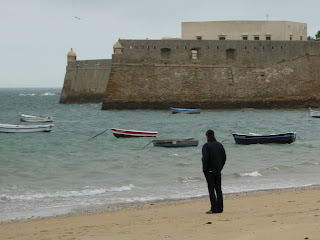
To avoid boring you to death, I'll combine two Italian cities, Trapani on Sicily and Cagliari on Sardinia. The shot above, taken through my cabin's salt stained windows, is of Trapani's main waterfront street. Smaller ports allow docking often only a stone's throw from a town's historic centre and a decent caffelatte.
There is, it is said, a church on every corner in Trapani. Mostly empty but for a few elderly women murmuring prayers. Many visitors feel obliged to check out every church in the local tourism office pamphlet, but I find peeling baroque, martyred saints and gloomy side altars unappealing, so this is the only chiesa you'll get from me.
Trapani is a Sicilian Mafia centre, second only to Palermo. Their current scam is laundering money through wind farms. There's an uneasy relationship between the Catholic Church and the Mafia. While away, the geriatric godfather of the Montreal Mafia has been murdered and, according to the ship's newspaper, got a church funeral. Why?
In a Trapani square, I found statues to local politicians who'd been killed by the Mafia.
I do like old cars. Both Trapani and Cagliari supplied a feast of plucky Fiat 500s, mixing their distinctive sound with that of the waspish scooters in the narrow streets.
Trapani also offers molto Italian street life, perhaps not a big surprise in Italy. Click on the picture and look at the expression of the man in the centre. And the baby has clearly developed an early interest in Italian politics.
I came across this little girl exploring a seaside rock pool.
I watched for some minutes. The last place I can remember the pleasures of poking with a stick and discovering what the tide had left behind is New Brunswick, decades and decades ago.
Why is it that Cagliari, a small city on Sardinia, has electronic signs for bus users and the Toronto Transit Commission hasn't?
While awaiting the bus, one can study acceptable standards in Italian advertising, standards that would certainly never make it onto the TTC. Sorry about the unavoidable reflection, but the picture's worth studying.
The use of English is intriguing, but how many of the locals would get the point?
Marketing extends to the most wonderful windows in local restaurants. Definitely lunch here!
I lied: one more picture from a church, actually a chapel. While wandering around the Cagliari train station (with an impressive old steam engine on display), I came across this little chapel. One could be cynical and say it's understandable in a country with a history of some truly spectacular train crashes. On the other hand, it was a quiet place to sit and study an altar supported by train wheels.































































